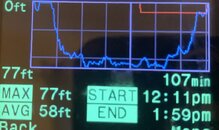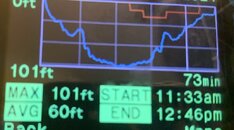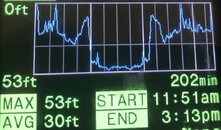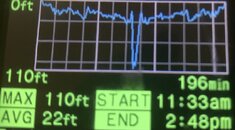Here’s a tale of two dives for those of you who worry about what dove planning software has to say.
A thing to know about the rule of 130: at 60 feet things go wonky… from 100 feet on up it adds up to 130… but then at 60 it jumps from the expected 70 minutes Of no deco to 100 minutes of no deco.
OK. So, two dives:
Both of them average about 60 feet. You see in the one that I could have come straight to the surface, deco ceiling having cleared on the way back, so with my average of 60, being under 100 minutes, I was no-deco diving the whole time. Even though I actually went into deco.
(But I had to wait around with my buddy who had their computer set to the default 30/70.)
The other one was actually shallower. But since I stayed longer, over the 100 minutes, my deco ceiling didn’t clear. I had to wait out about minutes more of deco (because I’d overstayed by about 2 minutes (if you’re already having trouble following… don’t ask).
I can find a dozen other screenshots that illustrate a dozen other angles to this.
But my question is: what does the desktop planning software that is oh so smart and valuable about this have to say about these dives? And does it mean my Shearwaters are wrong for agreeing with me and my horrible, horrible ideas?
A thing to know about the rule of 130: at 60 feet things go wonky… from 100 feet on up it adds up to 130… but then at 60 it jumps from the expected 70 minutes Of no deco to 100 minutes of no deco.
OK. So, two dives:
Both of them average about 60 feet. You see in the one that I could have come straight to the surface, deco ceiling having cleared on the way back, so with my average of 60, being under 100 minutes, I was no-deco diving the whole time. Even though I actually went into deco.
(But I had to wait around with my buddy who had their computer set to the default 30/70.)
The other one was actually shallower. But since I stayed longer, over the 100 minutes, my deco ceiling didn’t clear. I had to wait out about minutes more of deco (because I’d overstayed by about 2 minutes (if you’re already having trouble following… don’t ask).
I can find a dozen other screenshots that illustrate a dozen other angles to this.
But my question is: what does the desktop planning software that is oh so smart and valuable about this have to say about these dives? And does it mean my Shearwaters are wrong for agreeing with me and my horrible, horrible ideas?







